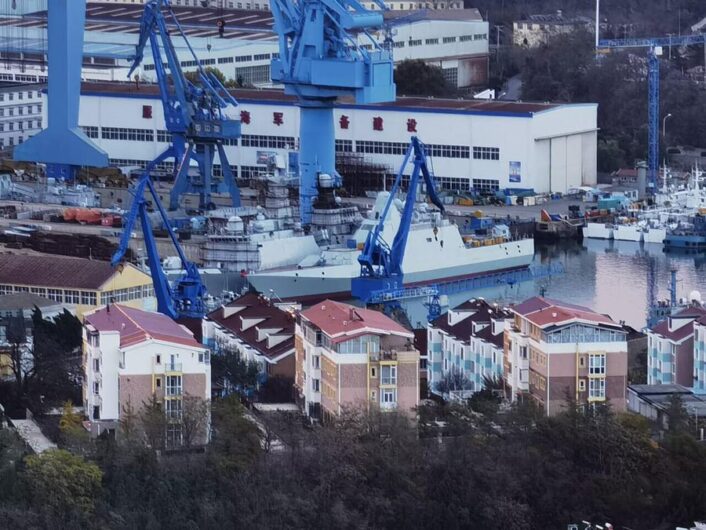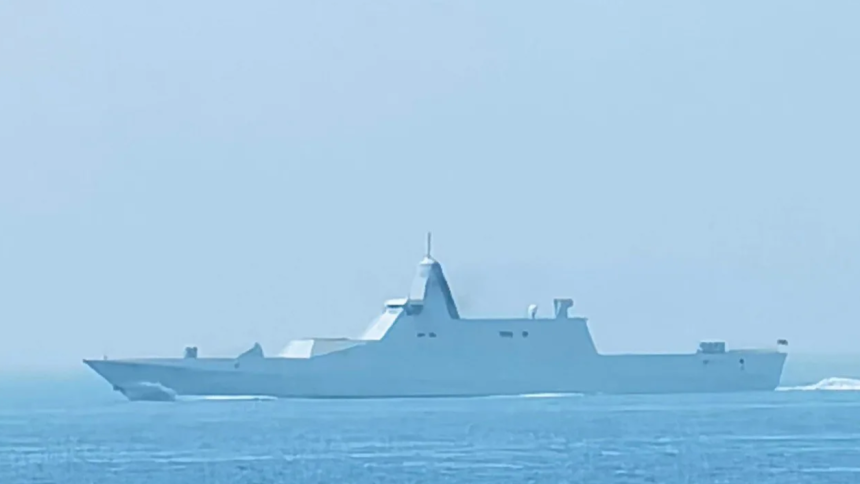The ship has emerged at a time when navies are exploring ways to unburden bigger capital warships like destroyers of routine tasks.
Photos of what appears to be a Chinese stealth warship on social media during its maiden sea voyage have raised intrigue, baring both its navy’s force multiplying effects and new naval warfare concepts. The ship design shares striking similarities with Sweden’s Visby-class stealth corvettes, with angled surfaces and an integrated mast with no protruding antennas.
While the ship remains unidentified, it nevertheless seems to be in consonance with an emerging naval thinking to possess medium-sized to small vessels to take the load off frontline destroyers. This is while being armed with potent sensors, radars and guided anti-air and anti-ship missiles.
Such designs are highly useful in littoral zones, which characterize many of the maritime regions in the SCS (South China Sea), particularly along the First Island Chain. Here, China has long been locked in maritime boundary claims with countries like the Philippines and Vietnam.
Images Appear at Shipyard and then Sea Trials
Naval expert and retired submariner Tom Shugart, estimated the ship is 97-meters long, and is a “stealthy surface combatant.” The ship was first seen in full form in November 2023 at a shipyard at Dalian in the Liaoning Province. Andreas Rupprecht, a leading Chinese military watcher and analyst recently posted the pictures of the unidentified vessel while it was now out at sea. He said he gathered that it was a “comprehensive testing platform.”
Something for the naval guys … seems as if that small stealthy unknown corvette – or light frigate-sized surface combatant – is out at sea.
Based on what i found it is an undesignated “comprehensive test platform”.@AlexLuck9 @CovertShores @navalnewscom @xaviervav @horobeyo pic.twitter.com/gjQIcUmwor
— @Rupprecht_A (@RupprechtDeino) May 12, 2024
A post claimed to be originating from China’s Weibo social media platform on many Telegram channels said: “A warship the size of a frigate without identification marks has been spotted in China. It is believed that the ship could be a test platform.”
This ship’s defining feature is its main gun, encased in a cupola, like the (AGS) Advanced Gun System on the USS Zumwalt. Behind the gun, it is sporting multiple VLS (Vertical Launch Silos) that could hold guided missiles. It also sports what could be an HQ-10 point missile defense system, near the stern above the helicopter deck.
Current Trends in Naval Thinking
While there has been no evidence of additional hulls of the class being built, a few informed guesses can be made about what vision PLAN commanders have for the ship. For one, the ship could actually be used for testing various under-development naval systems like radars, sensors or even EW (electronic warfare) equipment, before rolling them out on its flagship vessels.
Assuming it is for combat, it would be an overstatement to say that such a platform would not have military relevance and that PLA (People’s Liberation Army) Navy planners have not envisaged any naval warfare role for it. The ship has emerged at a time where navies are either exploring or have already implemented ways to unburden bigger capital warships like destroyers of routine tasks.

These include escorting, harbor security, anti-air, anti-surface tasks against drones and unmanned sea vehicles, point defense, ASW (Anti-Submarine Warfare) and even some anti-ship roles with smaller heavily armed missile boats, corvettes and USVs (Unmanned Surface Vessels) themselves.
What are Other Navies Doing?
The Russian Navy’s Pacific and Black Sea Fleets employ missile boats and corvettes like the Tarantul, Buyan-M or the Karakurt-class vessels. On April 26, 2024, the Pacific Fleet’s Tarantul fired Moskit cruise missiles against simulated targets in the Sea of Japan. The US Navy too is envisaging a 500-ship fleet made up of USVs and corvettes with the very same vision of freeing up its destroyers, spread out, get close and hit China inside its A2/AD anti-access (A2/AD) bubble.
Called the DMO (Distributed Maritime Operations) concept, it was envisaged by former Chief of Naval Operations Admiral Mike Gilday. This suggests the small, nimble and hard-to-detect boats, upgraded with the latest radars, fire control and communication systems, can be used for sinking adversary warships. The warship in question, with its heavily stealth-centric design, would be even harder to appear on search radars, particularly if it would be employing potent EW and spoofing technologies.
It could be undertaken in coordinated actions or independent of bigger destroyers with well-executed tactics and procedures by creating targeting dilemmas for an enemy vessel – depending upon the prevailing tactical situation. The larger destroyers and frigates can meanwhile focus on other land-strike and air defense roles – China’s case, for protecting its CBGs (Carrier Battle Groups).









